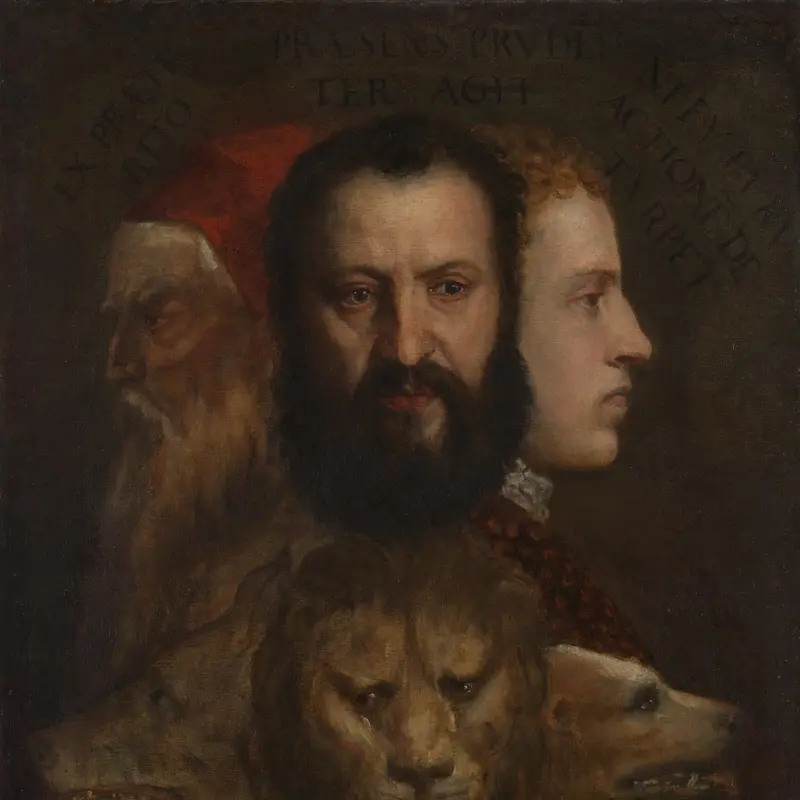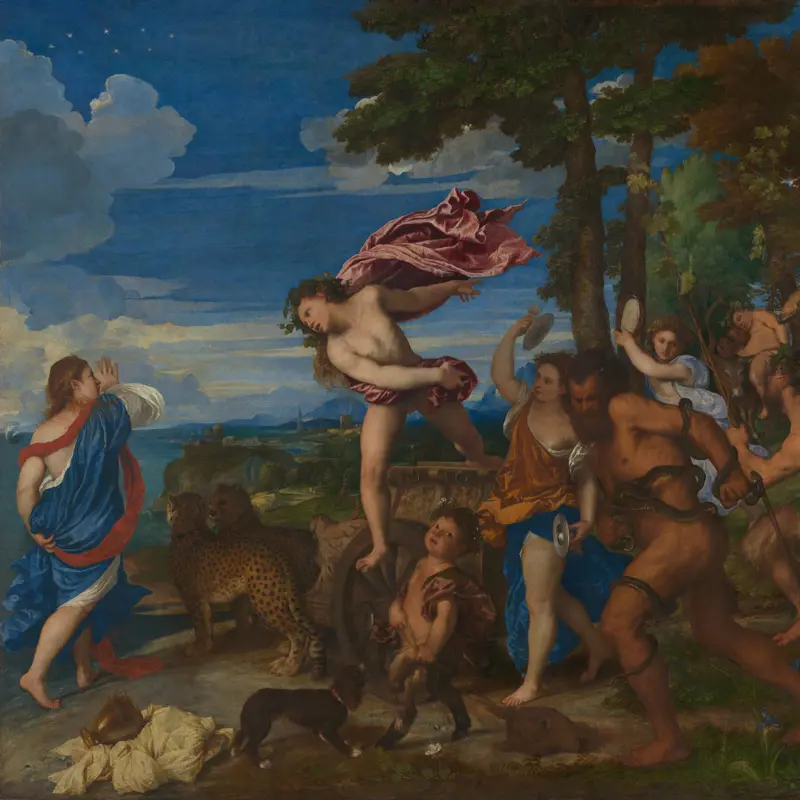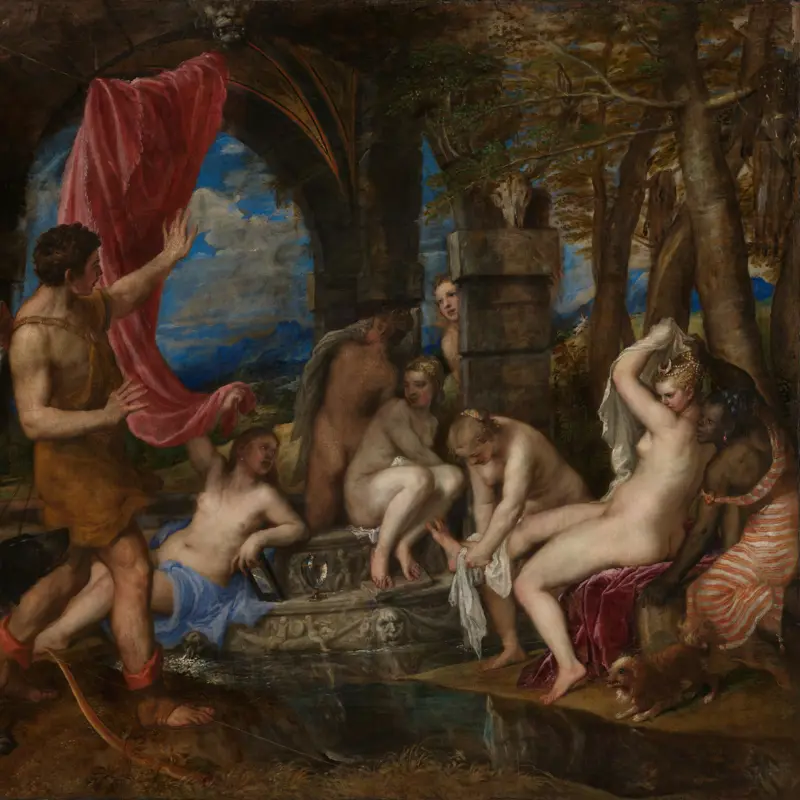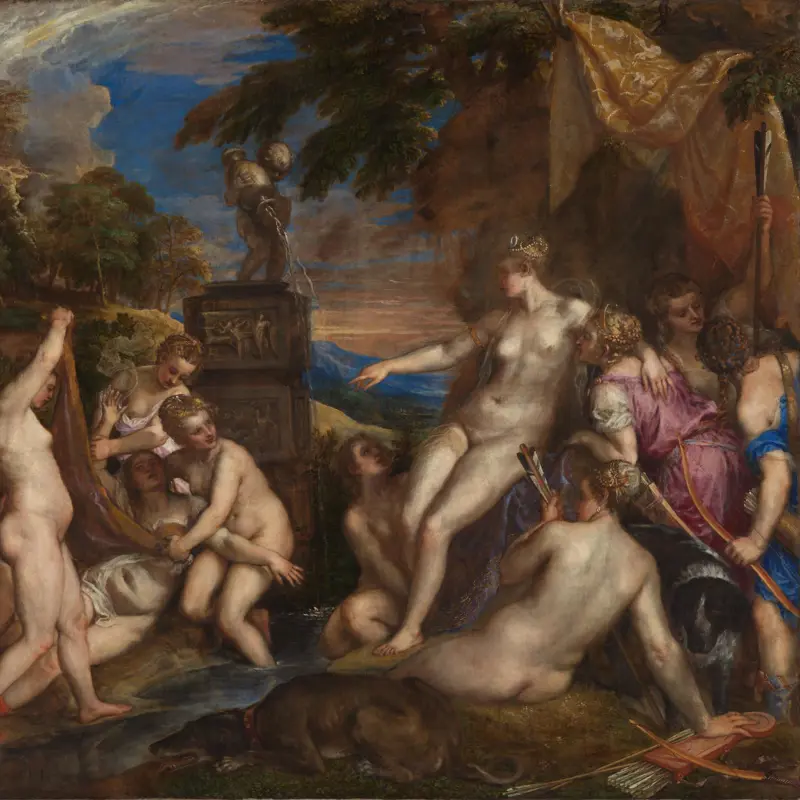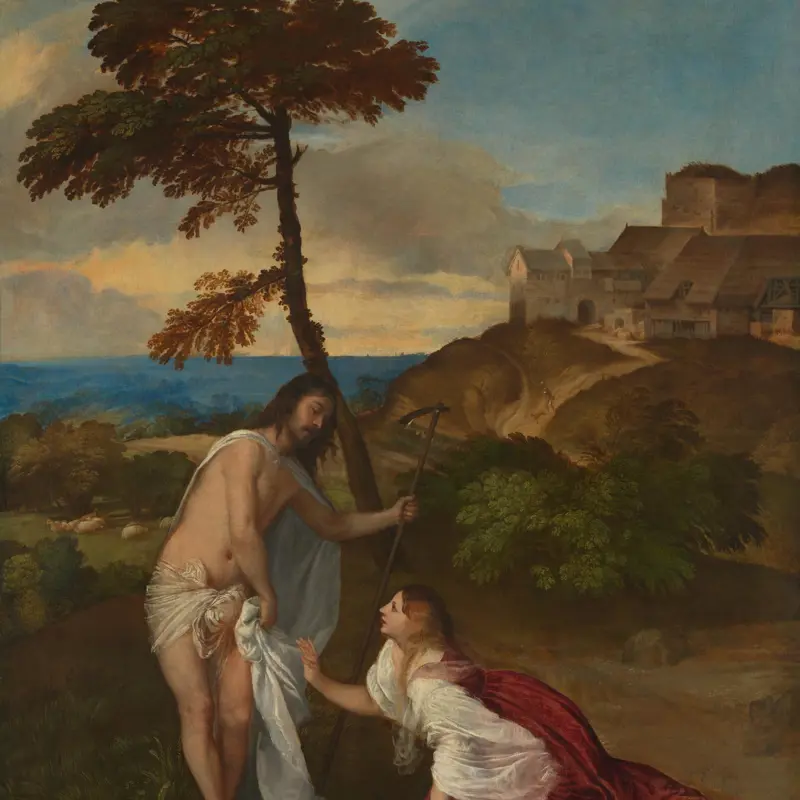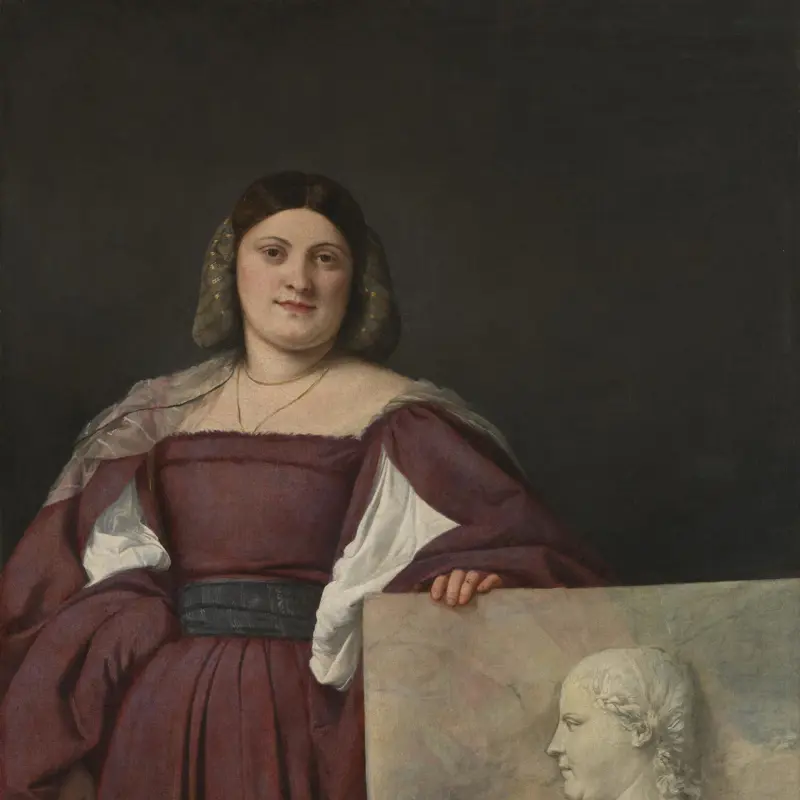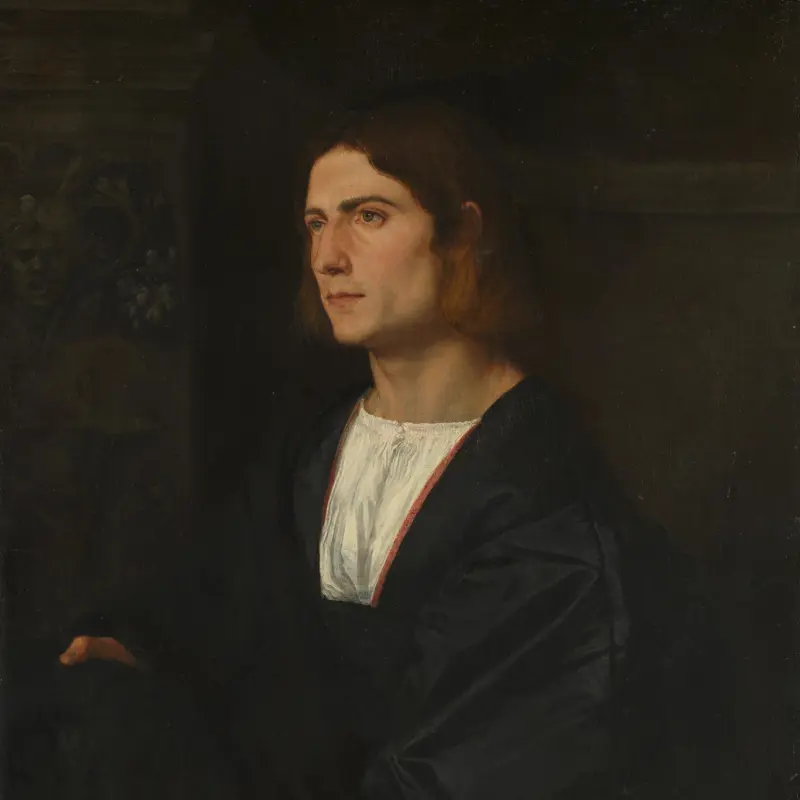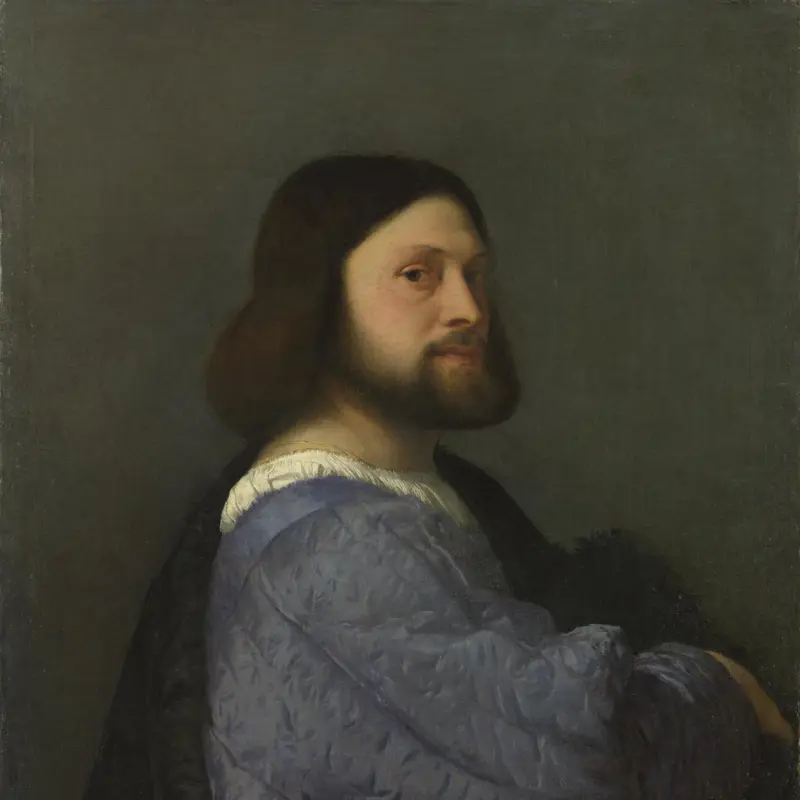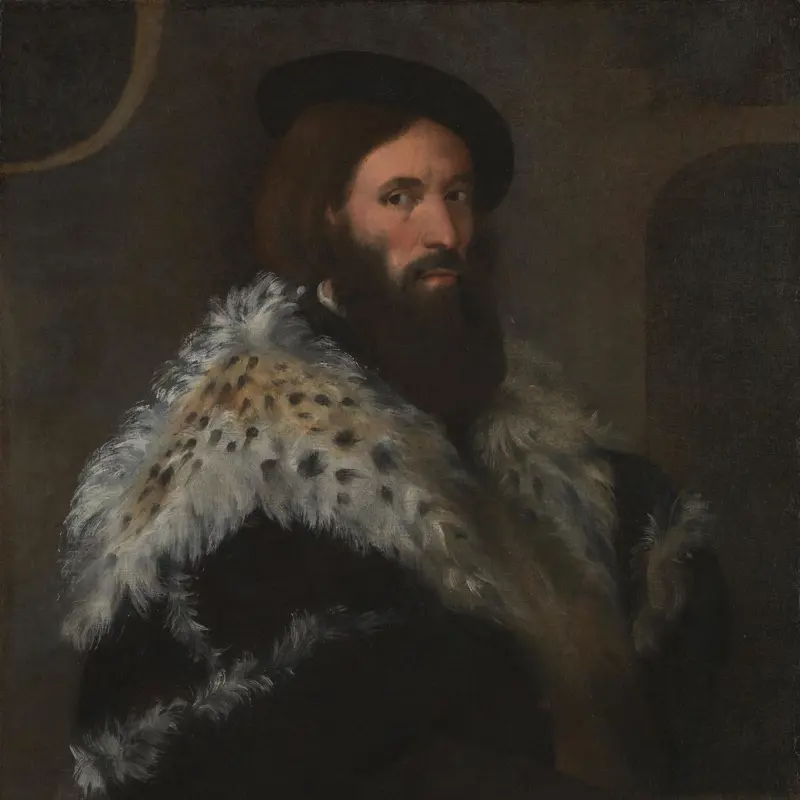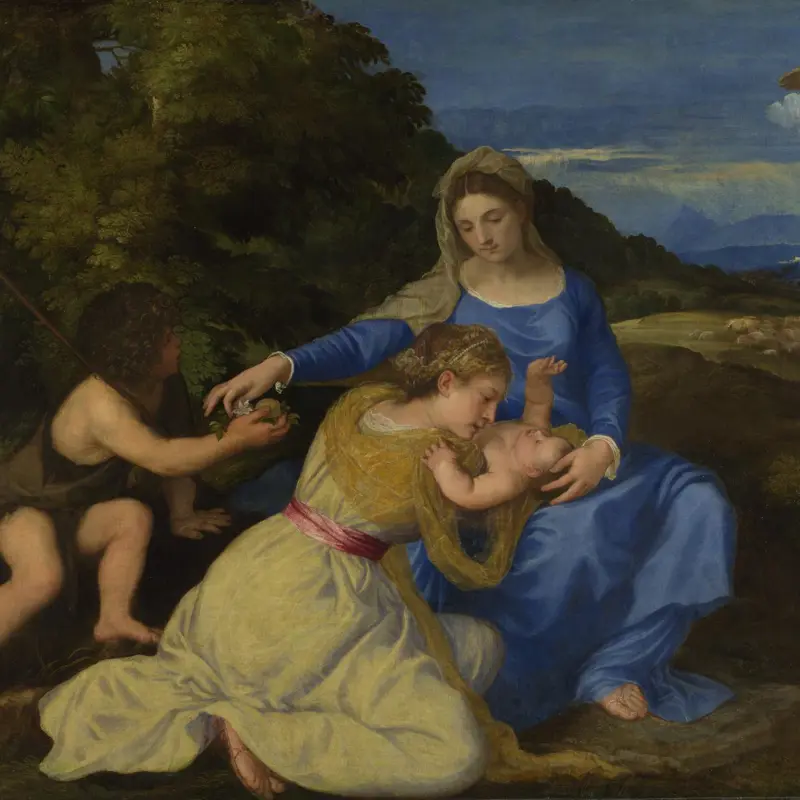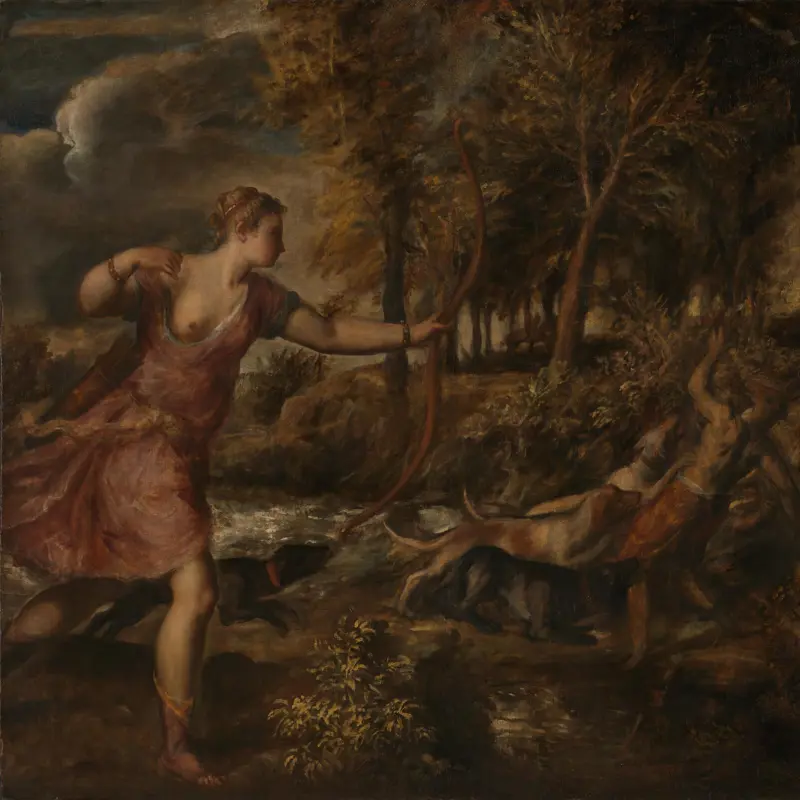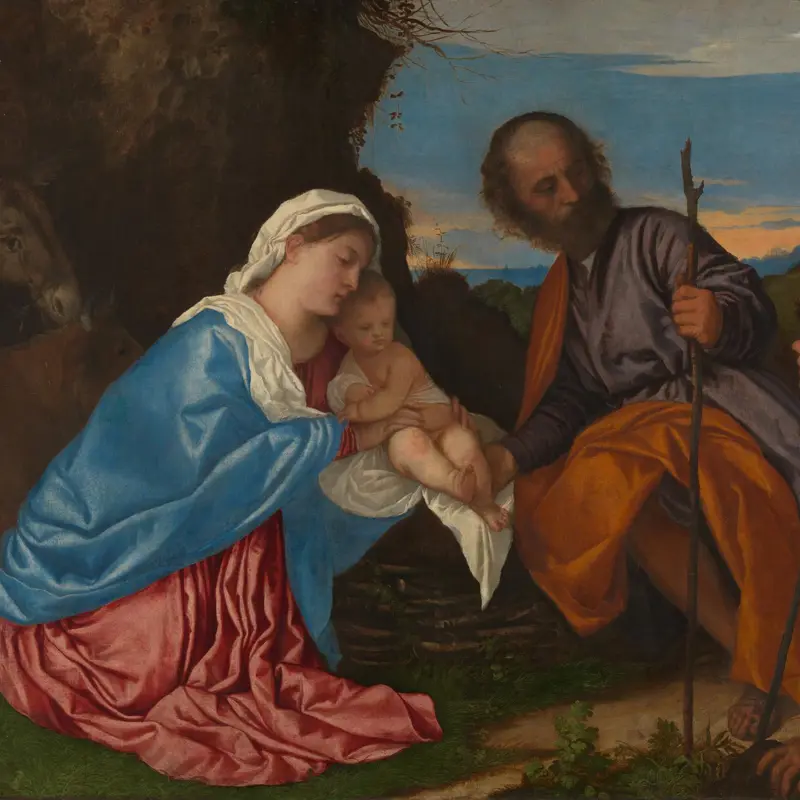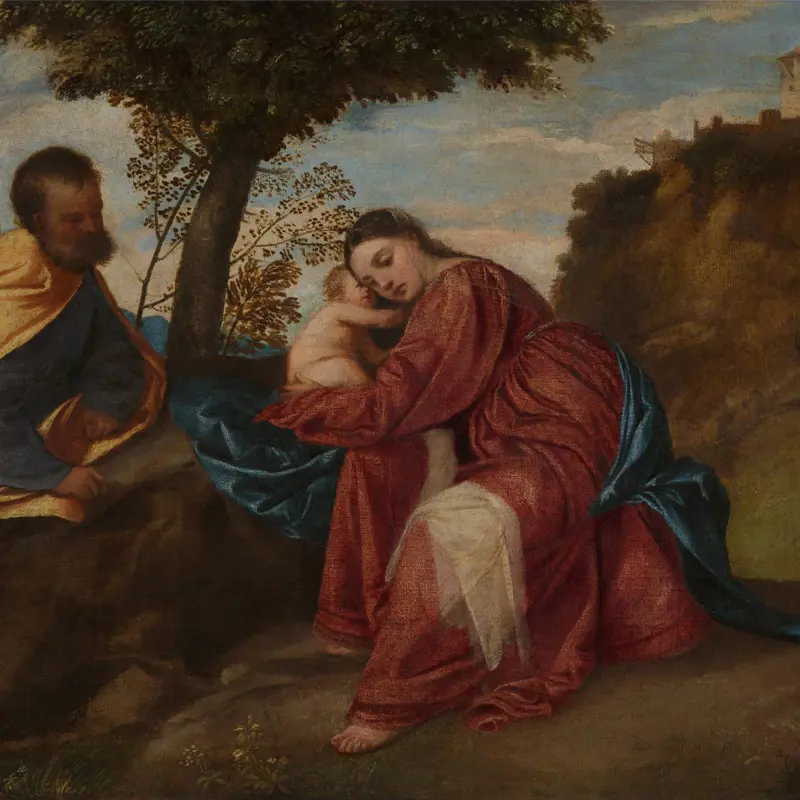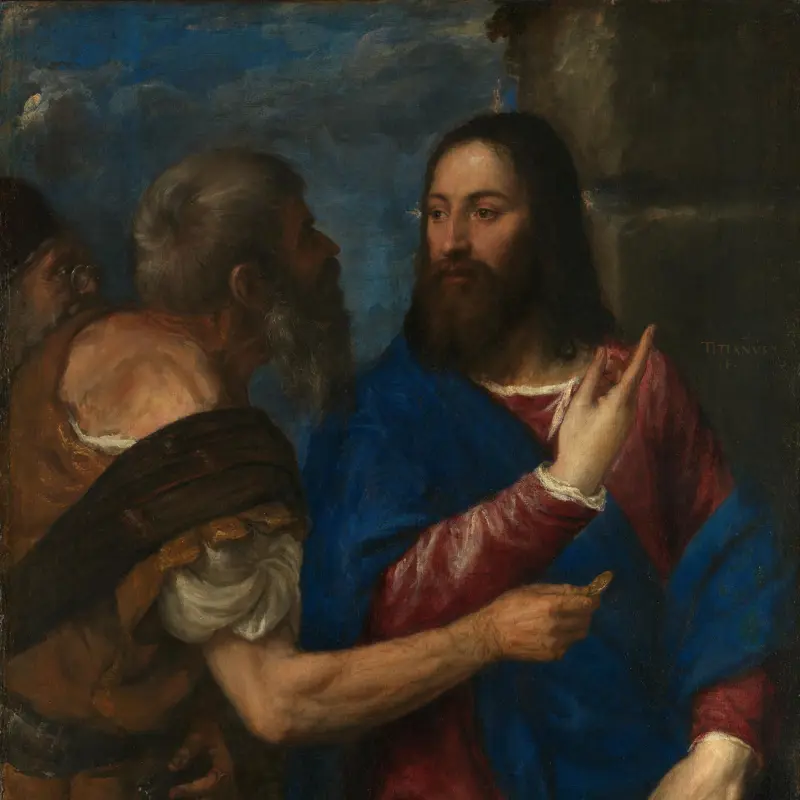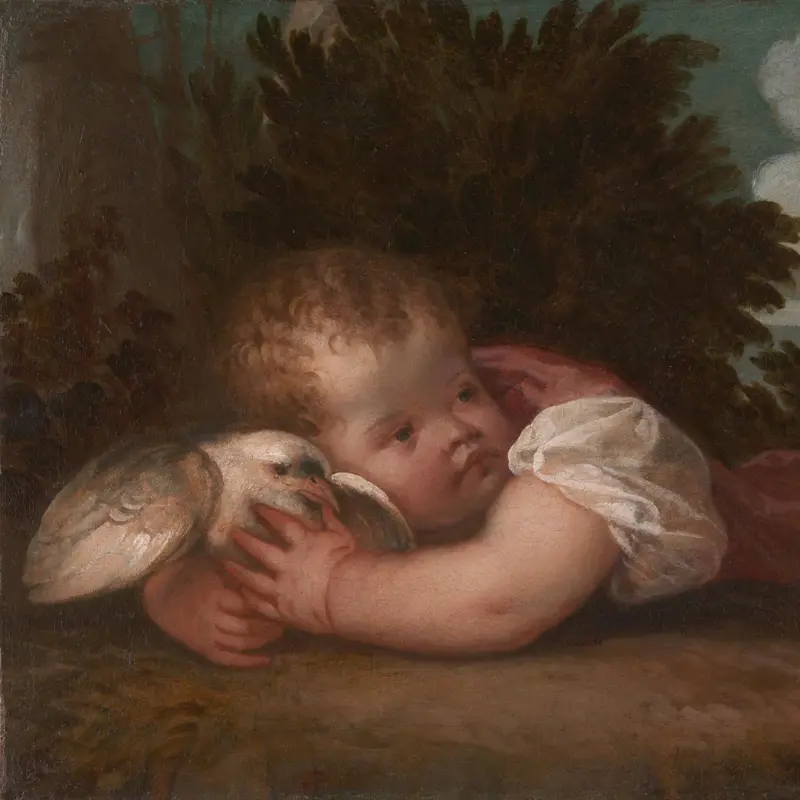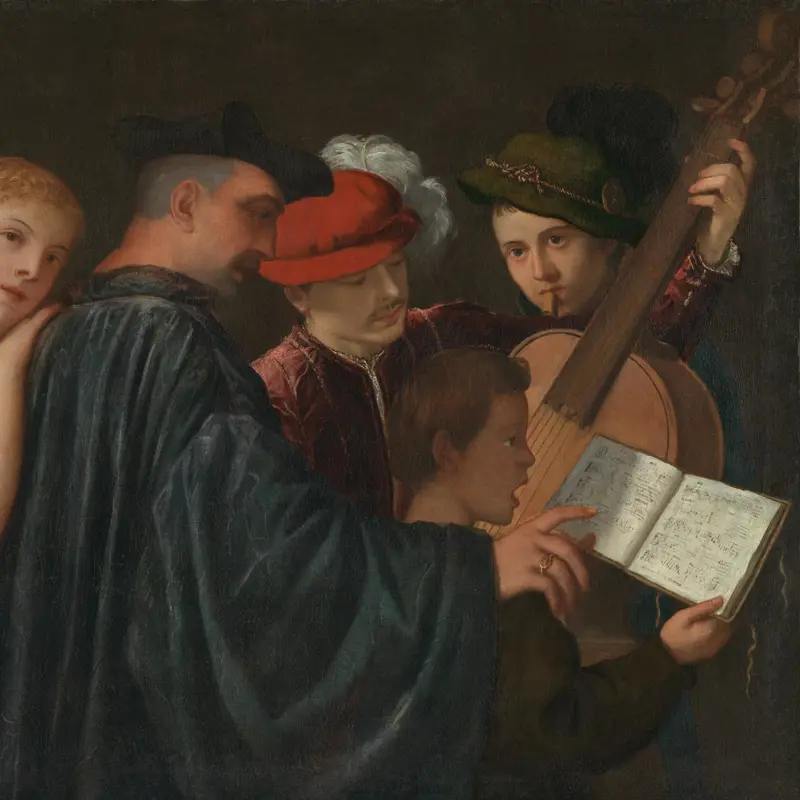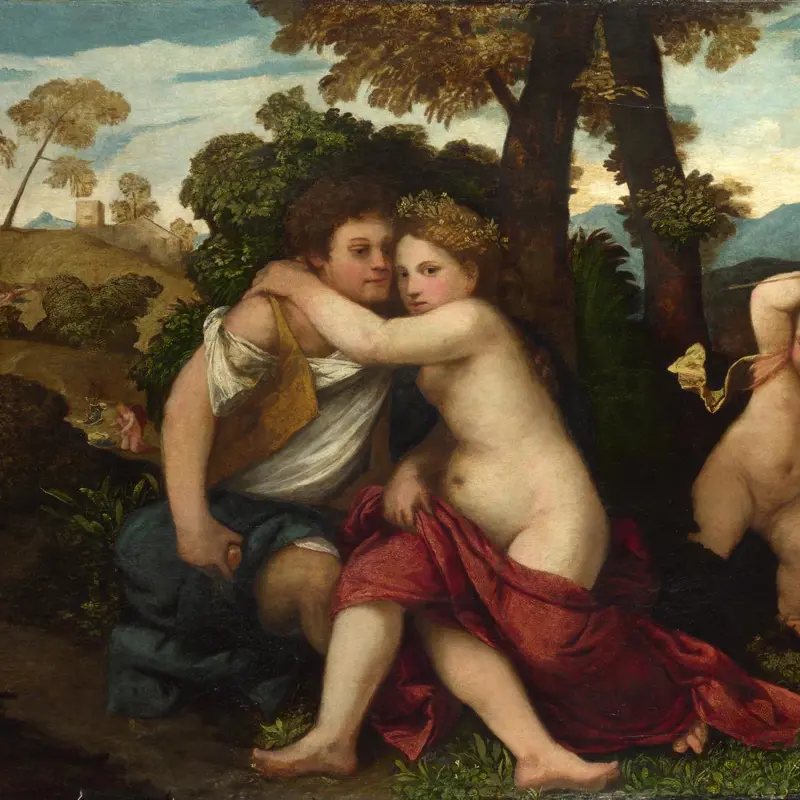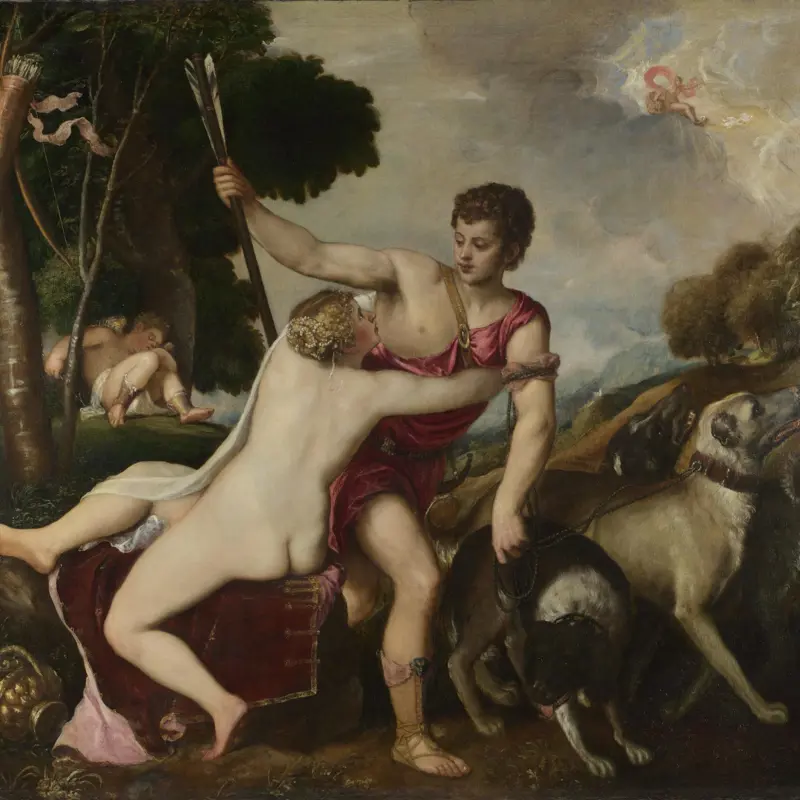Titian, 'The Virgin suckling the Infant Christ', about 1565-75
About the work
Overview
The Virgin Mary gazes at the infant Christ who feeds from her breast. The naked child is encircled in his mother’s arms and twists away from us. Our eye is drawn from the Virgin’s delicate fingers, up the line of Christ’s back and to the expression of devotion on her face.
Titian appears to be citing a very similar design by Michelangelo and does capture some of the grandeur and strength of his colleague’s figures in the Christ Child’s twisting pose and the Virgin’s heroic build, but he simultaneously brings a painterly softness and tenderness to his picture. The silvery harmonies combine with tremulous brushwork to make the solid forms of the Virgin and Child seem to dissolve into shimmering light.
Titian may have kept this painting in his studio and worked on it during the last years of his life. The unblended brushstrokes and restrained colour scheme are typical of his very late works such as The Death of Actaeon in the National Gallery.
Key facts
Details
- Full title
- The Virgin suckling the Infant Christ
- Artist
- Titian
- Artist dates
- active about 1506; died 1576
- Date made
- about 1565-75
- Medium and support
- oil on canvas
- Dimensions
- 76.2 × 63.5 cm
- Acquisition credit
- Mond Bequest, 1924
- Inventory number
- NG3948
- Location
- Room 8
- Collection
- Main Collection
- Frame
- 16th-century Venetian Frame
Provenance
Additional information
Text extracted from the ‘Provenance’ section of the catalogue entry in Nicholas Penny, ‘National Gallery Catalogues: The Sixteenth Century Italian Paintings’, vol. 2, ‘Venice 1540–1600’, London 2008; for further information, see the full catalogue entry.
Exhibition history
-
2017Renaissance Venice: The Triumph of Beauty and the Destruction of PaintingMuseo Nacional Thyssen-Bornemisza20 June 2017 - 24 September 2017
-
2022Fruits of the Spirit: Art from the HeartThe National Gallery (London)November 2022 - 9999
Bibliography
-
1854G.F. Waagen, Treasures of Art in Great Britain: Being and Account of the Chief Collections of Paintings, Drawings, Sculptures, Illuminated Mss. […], vol. 2, trans. E. Eastlake, London 1854
-
1877J.A. Crowe and G.B. Cavalcaselle, Titian: His Life and Times, London 1877
-
1898C. Phillips, The Later Work of Titian, London 1898
-
1904G. Gronau, Titian, London 1904
-
1910J.P. Richter, The Mond Collection: An Appreciation, London 1910
-
1910'The Ludwig Mond Bequest', The Burlington Magazine, XVI/83, 1910, pp. 251-2
-
1920L. Richter, Recollections of Dr. Ludwig Mond, London 1920
-
1924R. Fry, 'The Mond Pictures in the National Gallery', The Burlington Magazine, XLIV/254, 1924, pp. 234-46
-
1925C.H.C. Baker, National Gallery Catalogue, London 1925
-
1929C.H.C. Baker, National Gallery, Trafalgar Square: Catalogue, London 1929
-
1935W. Suida, Le Titien, Paris 1935
-
1936H. Tietze, Titian: Leben und Werk, 2 vols, Vienna 1936
-
1951F. Valcanover, 'La Mostra dei Vecellio a Belluno', Arte veneta, V, 1951, pp. 201-8
-
1957B. Berenson, Italian Pictures of the Renaissance: A List of the Principal Artists and Their Works, with an Index of Places: Venetian School, 2 vols, London 1957
-
1959Gould, Cecil, National Gallery Catalogues: The Sixteenth Century Venetian School, London 1959
-
1969H.E. Wethey, The Paintings of Titian: The Religious Paintings, 3 vols, London 1969
-
1975C. Gould, Delaroche and Gautier: Gautier's Views on the 'Execution of Lady Jane Grey' and on other Compositions by Delaroche, London 1975
-
1987Gould, Cecil, National Gallery Catalogues: The Sixteenth Century Italian Schools, London 1987
-
1987B. Bernard, Queen of Heaven: A Selection of Paintings of the Virgin Mary from the Twelfth to the Eighteenth Centuries, London 1987
-
1993F. Valcanover, 'Tiziano in Palazzo Ducale a Venezia: Un primo bilancio', Studies in the History of Art, XLV, 1993, pp. 16-27
-
1993M. Laclotte (ed.), Le siècle de Titien: L'âge d'or de la peinture à Venise (exh. cat. Galeries Nationales du Grand Palais, 9 March - 14 June 1993), Paris 1993
-
1996M. Mancini, 'I colori della bottega. Sui commerci di Tiziano e Orazio Vecellio con la corte di Spagna', Venezia cinquecento, VI/11, 1996, pp. 163-79
-
1997R. Goffen, Titian's Women, New Haven 1997
-
1999J. Dunkerton, S. Foister and N. Penny, Dürer to Veronese: Sixteenth-Century Painting in the National Gallery, London 1999
-
2001
C. Baker and T. Henry, The National Gallery: Complete Illustrated Catalogue, London 2001
-
2001F. Pedrocco, Titian: The Complete Paintings, London 2001
-
2003D. Jaffé (ed.), Titian, London 2003
-
2003D. Wardleworth, 'The "Friendly" Battle for the Mond Bequest', British Art Journal, IV/3, 2003, pp. 87-93
-
2003C. Hope et al., Titian (exh. cat. The National Gallery, 19 February - 18 May 2003; Museo Nacional del Prado, 10 June - 7 September 2003), London 2003
-
2006P. Hills, 'Titian's Veils', Art History, XXIX/5, 2006, pp. 771-95
-
2006C. Saumarez Smith et al., Ludwig Mond's Bequest: A Gift to the Nation (exh. cat. The National Gallery, 14 July - 29 October 2006), London 2006
-
2007S. Ferino Pagden, Der späte Tizian und die Sinnlichkeit der Malerei (exh. cat. Kunsthistorisches Museum, 18 October 2007 - 6 January 2008; Gallerie dell'Accademia, 1 Februrary - 21 April 2008), Vienna 2007
-
2008Penny, Nicholas, National Gallery Catalogues: The Sixteenth Century Italian Paintings, 2, Venice, 1540-1600, London 2008
-
2008S. Ferino Pagden, Late Titian and the Sensuality of Painting (exh. cat. Kunsthistorisches Museum, 18 October 2007 - 6 January 2008; Gallerie dell'Accademia (Venice), 26 January - 20 April 2008), Venice 2008
-
2022S. Avery-Quash and A. Lepine (eds), Fruits of the Spirit: Art from the Heart, London 2022
Frame
This is a sixteenth-century Italian cassetta frame from the Veneto region. It is carved from walnut wood and gilt, in an effect known as ‘lumeggiato in oro’. The back moulding has a gilt tongue and painted dart motif, followed by a double pearl-and-reel motif. An ornate frieze features an undulating pattern of flowers and leaves that resembles rambling roses, composed of five petals arranged in outer and inner circles, highlighted by a central pearl. These elements are fully gilded and were originally accented with red lacquer. The gilt stems and leaves, detailed with dark-coloured veins, stand out against the dark walnut wood, which is enhanced with punch-tooling. In the corners of the frame are gilt acanthus leaves. Closer to the sight moulding, diamond-shaped gilt pearls are accompanied by a gilt cavetto.
It is likely that the diamond pearls near the sight edge were originally lacquered. The frame was acquired in 2017 and to accommodate Titian’s The Virgin suckling the Infant Christ was fitted with a walnut slip.
About this record
If you know more about this work or have spotted an error, please contact us. Please note that exhibition histories are listed from 2009 onwards. Bibliographies may not be complete; more comprehensive information is available in the National Gallery Library.

